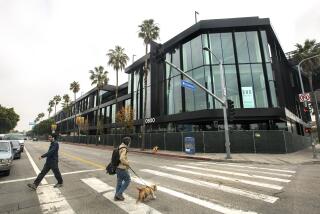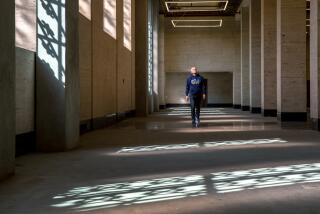School With a View
- Share via
When Hughes Aircraft Co. reigned in Westchester, it was the workers at the secrecy-shrouded company who enjoyed the panoramic view from the bluffs at the intersection of Hughes Terrace and Lincoln Boulevard: Marina del Rey, the Ballona Wetlands, the skyscrapers in Century City.
Although the old “Hughes Terrace” street sign is still up, the road became “LMU Drive” three months ago, and these days the people appreciating the setting are students at Loyola Marymount University.
That is one of several changes since Loyola Marymount, a Roman Catholic university located on the bluffs since 1928, acquired the former Hughes world headquarters building last year for $75.5 million.
The 680,000-square-foot building gave the university spacious new quarters to house its ranking administrators as well as the departments of mathematics, sociology, Chicano studies, history, English, economics and education. The building was remodeled to add 30 classrooms with state-of-the-art computer and video equipment.
“To have classrooms where what once was a top-secret place is a rare kind of setting,” said Chris Weir, 22, a senior majoring in theological studies and Loyola Marymount’s student body president. “And it has a beautiful view.”
The acquisition has allowed the university to close its main entrance on Loyola Boulevard at night, cheering some nearby Westchester residents who had tired of the continual campus traffic. Now, between 11 p.m. and 6 a.m., motorists must use the entrance on LMU Drive, off Lincoln, to enter the campus.
In the old days, Hughes Terrace was a dead-end street that served only the Hughes building. To help solve traffic problems and to create another campus entrance, university officials extended the renamed thoroughfare to the rest of the campus.
Although the new classroom building’s interior looks more like a shopping mall because of its four-level atrium, the new occupants are happy with it.
“Being in this building gives us more visibility,” said Fernando J. Guerra, director of the university-based Center for the Study of Los Angeles.
And there’s an added bonus for Loyola Marymount’s 6,000 students who drive to campus.
Because the former Hughes building--now called University Hall--has underground parking for 1,150 vehicles on three levels, students will be entitled to free campus parking next fall. They now pay $200 a year to park on campus.
“I think the free parking is great,” said sophomore Amanda Phillips, 19.
INTERSECTIONS
Life at the crossroads
of Southern California
* One in an occasional series
The Hughes building has been a landmark since it was built in the mid-1980s. It was built into the bluffs at the insistence of locals, who didn’t want the structure to obstruct the spectacular views. These days, anyone on the campus has a commanding view of the work on the massive Playa Vista planned community, which is just getting underway.
Raytheon Co., which acquired the Hughes Aircraft operation in 1997, agreed to sell the land to the university.
In addition to extending the one-time Hughes street to the campus, the university spent more than $1 million for a pedestrian bridge to connect the structure with the campus.
As the university completes its takeover of the building, some officials can’t get over the fact that it was once the headquarters for Hughes Aircraft, whose founder, industrialist Howard Hughes, had a legendary penchant for secrecy.
David Trump, Loyola Marymount’s vice president for facilities management, remembered that when Hughes still owned the building, university officials were not afforded a complete tour because of the sensitive nature of the defense-industry work being done there.
“We had to be under escort,” Trump recalled the other day. “You had to have a very specific reason to be there.”
Homeowners in Westchester, where houses near campus range in value from $350,000 to more than $800,000, are generally pleased with the university’s acquisition of the Hughes building because it means less traffic and fewer parking problems in the area near the school’s core 100-acre campus.
“Overall, the effect on the neighborhood has been positive,” said Westchester resident Maureen Jay, who is chairwoman of the school’s neighborhood advisory committee. “And I live close enough to hear the bells chime [on campus].”
In the past, homeowners have criticized some university moves. When the school proposed to develop nearly 28 acres on the Westchester bluffs next to campus, community opposition was swift. Through the formation of the neighborhood advisory group, homeowners vented their anger about developing the area, saying it was environmentally unsound.
Eventually, the university gained support to build three residence halls, a 900-car underground garage topped by an athletic field and the Hilton Center for Business on the property, known as the Leavey campus.






